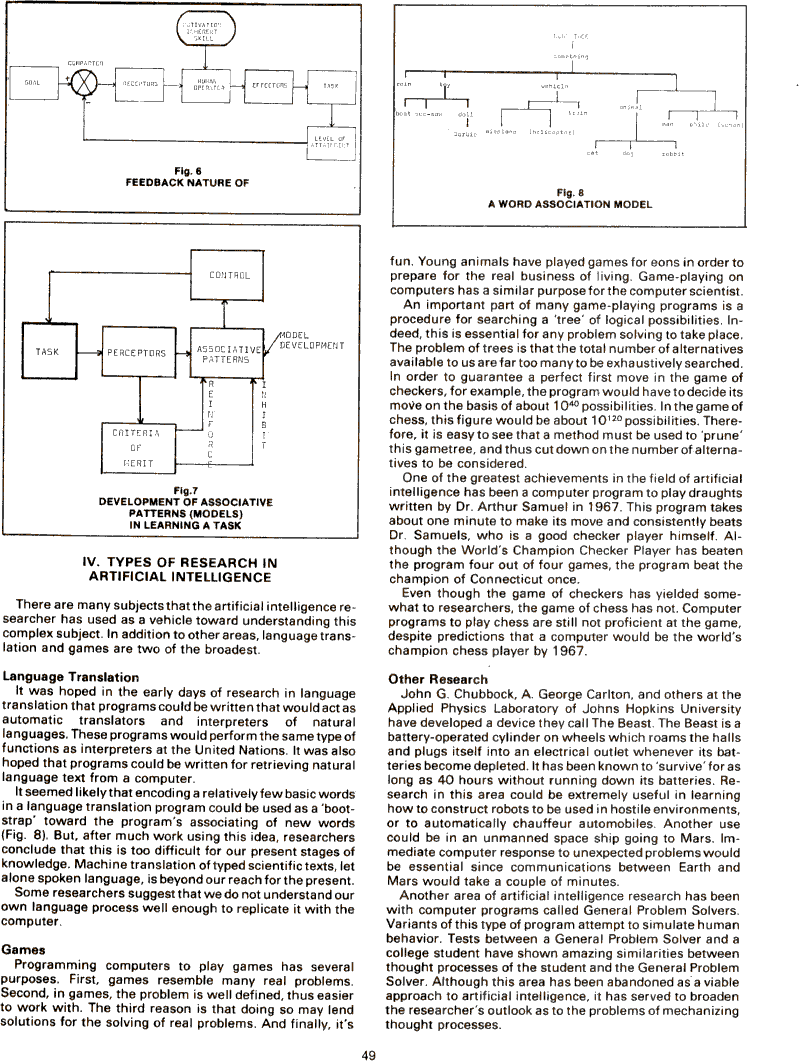The Best of Creative Computing Volume 2 (published 1977)
Primer on Artificial Intelligence (Types of Research in Artificial Intelligence, language translation, games)

[image]Fig. 6
FEEDBACK NATURE OF
***
[image]Fig. 7
DEVELOPMENT OF ASSOCIATIVE PATTERNS (MODELS) IN LEARNING A TASK
***
[image]Fig. 8
A WORD ASSOCIATION MODEL
***
IV. TYPES OF RESEARCH IN ARTIFICIAL INTELLIGENCE
There are many subjects that the artificial intelligence researcher has used as
a vehicle toward understanding this complex subject. In addition to other areas,
language translation and games are two of the broadest.
***
Language Translation
It was hoped in the early days of research in language translation that programs
could be written that would act as automatic translators and interpreters of
natural languages. These programs would perform the same type of functions as
interpreters at the United Nations. It was also hoped that programs could be
written for retrieving natural language text from a computer.
It seemed likely that encoding a relatively few basic words in a language
translation program could be used as a 'bootstrap' toward the program's
associating of new words (Fig. 8). But, after much work using this idea,
researchers conclude that this is too difficult for our present stages of
knowledge. Machine translation of typed scientific texts, let alone spoken
language, is beyond our reach for the present.
Some researchers suggest that we do not understand our own language process well
enough to replicate it with the computer.
***
Games
Programming computers to play games has several purposes. First, games resemble
many real problems. Second, in games, the problem is well defined, thus easier
to work with. The third reason is that doing so may lend solutions for the
solving of real problems. And finally, it's fun. Young animals have played games
for eons in order to prepare for the real business of living. Game-playing on
computers has a similar purpose for the computer scientist.
An important part of many game-playing programs is a procedure for searching a
'tree' of logical possibilities. Indeed, this is essential for any problem
solving to take place. The problem of trees is that the total number of
alternatives available to us are far too many to be exhaustively searched. In
order to guarantee a perfect first move in the game of checkers, for example,
the program would have to decide its move on the basis of about 10 40
possibilities. In the game of chess, this figure would be about 10 120
possibilities. Therefore, it is easy to see that a method must be used to
'prune' this gametree, and thus cut down on the number of alternatives to be
considered.
One of the greatest achievements in the field of artificial intelligence has
been a computer program to play draughts written by Dr. Arthur Samuel in 1967.
This program takes about one minute to make its move and consistently beats Dr.
Samuels, who is a good checker player himself. Although the World's Champion
Checker Player has beaten the program four out of four games, the program beat
the champion of Connecticut once.
Even though the game of checkers has yielded somewhat to researchers, the game
of chess has not. Computer programs to play chess are still not proficient at
the game, despite predictions that a computer would be the world's champion
chess player by 1967.
***
Other Research
John G. Chubbock, A. George Carlton, and others at the Applied Physics
Laboratory of Johns Hopkins University have developed a device they call The
Beast, The Beast is a battery-operated cylinder on wheels which roams the halls
and plugs itself into an electrical outlet whenever its batteries become
depleted. It has been known to 'survive' for as long as 40 hours without running
down its batteries. Research in this area could be extremely useful in learning
how to construct robots to be used in hostile environments, or to automatically
chauffeur automobiles. Another use could be in an unmanned space ship going to
Mars. Immediate computer response to unexpected problems would be essential
since communications between Earth and
Mars would take a couple of minutes.
Another area of artificial intelligence research has been with computer programs
called General Problem Solvers. Variants of this type of program attempt to
simulate human behavior. Tests between a General Problem Solver and a college
student have shown amazing similarities between thought processes of the student
and the General Problem Solver. Although this area has been abandoned as a
viable approach to artificial intelligence, it has served to broaden the
researcher's outlook as to the problems of mechanizing
thought processes.
***
49


